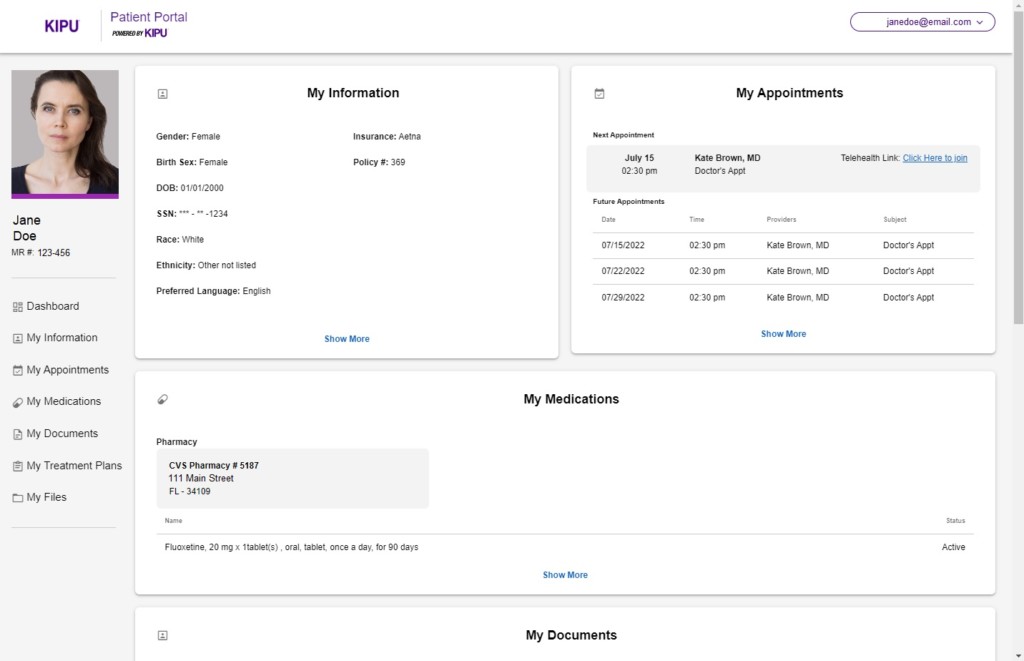The Kipu Patient Portal enables patients to cut through stifling red tape and maintain a healthy recovery path
By Jason Langendorf
Technology in the healthcare and behavioral health fields can take on a range of forms, from robotics and cutting-edge body scans to ingestible monitors and cool medication- or treatment-delivery gadgets that appear to have been beamed straight from the Star Trek sick bay.
And then there’s what Kipu Health, a Florida-based behavioral health software solutions company, introduced this week: the Kipu Patient Portal.
The portal, essentially an online information-sharing admin platform, may not set many pulses racing among tech fans or sci-fi buffs, but experts in the field are understandably excited about its potential to change—and save—lives. By allowing addiction treatment patients and their authorized contacts to easily exchange clinical and administrative documentation, view appointments and medications, launch telehealth sessions and more—all in real time and from wherever they may be—the Kipu Patient Portal is streamlining processes and creating touchpoints that help patients stay on their treatment path.

“The patient portal is a game-changer for treatment centers and their patients,” says Sally Abu-moustafa, executive vice president of product management at Kipu. “With this level of insight and access to treatment plans, patients and their loved ones can easily view and react to key milestones on their care journey. With real-time information and provider access at their fingertips, the portal engages patients in their care plan, which is crucial to positive outcomes.”
The Early Returns
Kipu registered almost 10,000 users during the portal’s beta-launch phase, according to Abu-moustafa, who says that the platform will benefit caregivers and key staff as well as patients. When connected to the Kipu Electronic Medical Record (EMR) platform, the patient portal can cut down the back-and-forth of information sharing, essentially helping behavioral health facilities boost their efficiency and level of care from dial-up to broadband.
“The patient portal is a vital extension of our care experience, so we’re thrilled to be able to provide this access and convenience for our patients,” said Melva Avila, EMR manager at Monte Nido and Affiliates, a Miami-based eating disorders treatment clinic. “By adding the ability for our patients and their caregivers to see their medical information and view appointments, we’re delivering the comfort and support they need for a successful recovery.”
The practical value of the portal, Abu-moustafa says, lies in its ease of use and empowering of both patients and care team members to share information, sign documents and expedite processes that can sometimes slow down the delivery of treatment or critical response times.
“Because treatment is fluid, the portal allows the care team member, for example, to share an update to a treatment plan,” Abu-moustafa says. “Perhaps a new objective was added that the patient is now charged with addressing, so, in real time, the patient is able to receive and respond to that information seamlessly.
“They’re able to view their list of medications and instructions for use. They’re able to see the appointments that they have scheduled or launch a telehealth session directly from the portal.”
“When a patient decides to enter treatment, it’s very important that they’re able to access the treatment they need when that decision is made.”
—Sally Abu-moustafa, Kipu Health
Integration with Kipu’s cloud-based EMR platform (found in more than 1,600 facilities worldwide) is an important differentiator, according to Abu-moustafa, because it allows for the tracking and management of the complete patient life cycle at a time when staffing shortages are dinging the healthcare industry and in a space where any missed step, any wasted second, could have dire consequences.
“When a patient decides to enter treatment, it’s very important that they’re able to access the treatment they need when that decision is made,” says Abu-moustafa. “So any obstacles we can remove along the way to expedite the process—to qualify the patient, to get them the information that they need and to arrange for their treatment to begin—is a benefit that the portal provides.”
Top photo: Alexander Shatov













